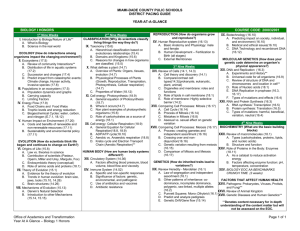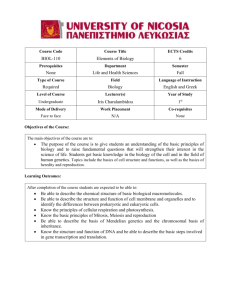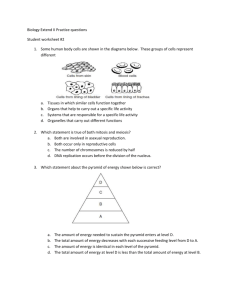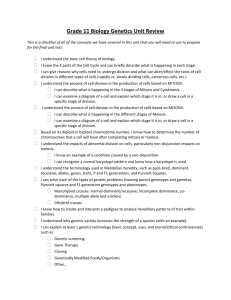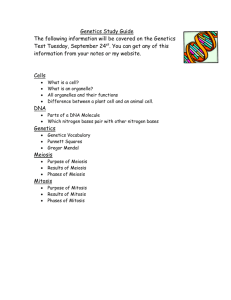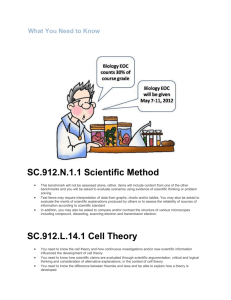AP Biology Syllabus 2014-2015
advertisement
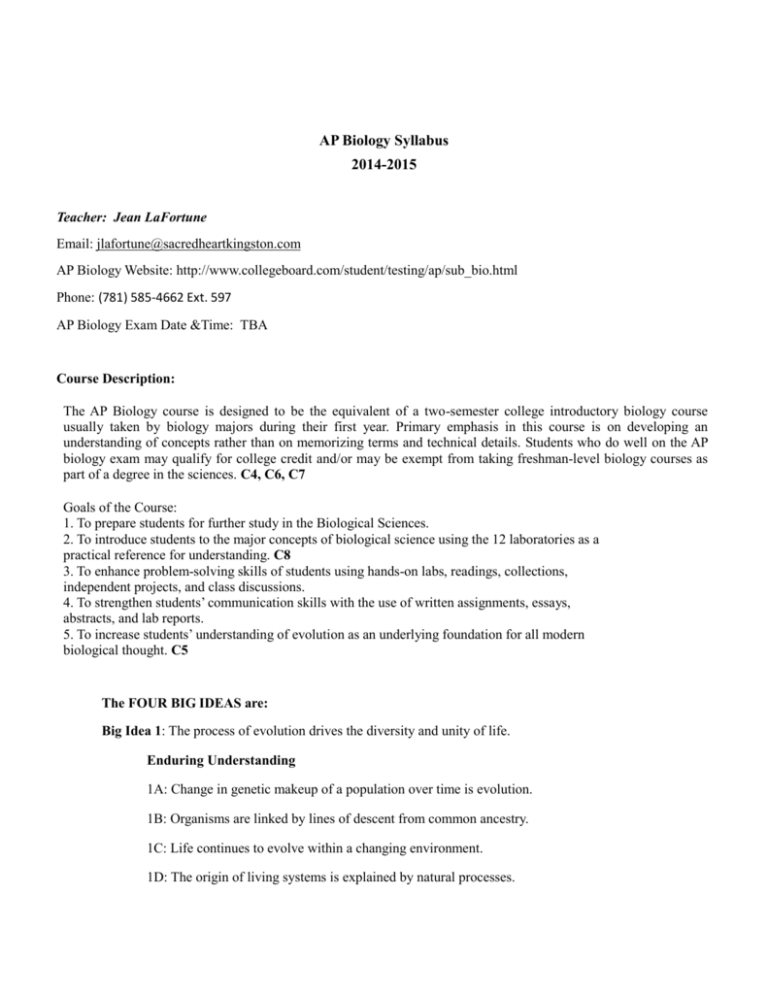
AP Biology Syllabus 2014-2015 Teacher: Jean LaFortune Email: jlafortune@sacredheartkingston.com AP Biology Website: http://www.collegeboard.com/student/testing/ap/sub_bio.html Phone: (781) 585-4662 Ext. 597 AP Biology Exam Date &Time: TBA Course Description: The AP Biology course is designed to be the equivalent of a two-semester college introductory biology course usually taken by biology majors during their first year. Primary emphasis in this course is on developing an understanding of concepts rather than on memorizing terms and technical details. Students who do well on the AP biology exam may qualify for college credit and/or may be exempt from taking freshman-level biology courses as part of a degree in the sciences. C4, C6, C7 Goals of the Course: 1. To prepare students for further study in the Biological Sciences. 2. To introduce students to the major concepts of biological science using the 12 laboratories as a practical reference for understanding. C8 3. To enhance problem-solving skills of students using hands-on labs, readings, collections, independent projects, and class discussions. 4. To strengthen students’ communication skills with the use of written assignments, essays, abstracts, and lab reports. 5. To increase students’ understanding of evolution as an underlying foundation for all modern biological thought. C5 The FOUR BIG IDEAS are: Big Idea 1: The process of evolution drives the diversity and unity of life. Enduring Understanding 1A: Change in genetic makeup of a population over time is evolution. 1B: Organisms are linked by lines of descent from common ancestry. 1C: Life continues to evolve within a changing environment. 1D: The origin of living systems is explained by natural processes. Big Idea 2: Biological systems utilize free energy and molecular building blocks to grow, to reproduce and to maintain dynamic homeostasis. Enduring Understanding 2A: Growth, reproduction and maintenance of the organization of the living systems requires free energy and matter. 2B: Growth, reproduction and dynamic homeostasis require that cells create and maintain internal environments that are different from their external environments. 2C: Organisms use feedback mechanisms to regulate growth and reproduction, and to maintain dynamic homeostasis. 2D: Growth and dynamic homeostasis of a biological system are influenced by changes in the system’s environment. 2E: Many biological processes involved in growth, reproduction and dynamic homeostasis include temporal regulation and coordination. Big Idea 3: Living systems store, retrieve, transmit and respond to information essential to life processes. Enduring Understanding 3A: Heritable information provides for continuity of life. 3B: Expression of genetic information involves cellular and molecular mechanisms. 3C: The processing of genetic information is imperfect and is a source of genetic variation. 3D: Cells communicate by generating transmitting and receiving chemical signals. 3E: Transmission of information results in changes within and between biological systems. Big Idea 4: Biological systems interact, and these systems and their interactions possess complex properties. Enduring Understanding 4A: Interactions within biological systems lead to complex properties. 4B: Competition and cooperation are important aspects of biological systems. 4C: Naturally occurring diversity among and between components within biological systems affects interactions with the environment. Textbook & Study Resources: --Campbell Biology in Focus, AP Edition with Student Media CD --5 STEPS TO A 5 AP BIOLOGY, 2014-2015 EDITION Edition: 6th Teaching Strategies: Class lectures /discussions. Class time is spent on class lectures/discussions. Students are given reading assignments prior to class and are expected to come to class prepared to take part in lecture/discussion. All lecture notes are given via PowerPoint and LCD projector. The PowerPoint notes include various graphics and hyperlinks that help to promote better conceptual understanding. Course Planner Unit plans for each unit will be distributed at the beginning of the unit. Class Scheduling The AP biology class will be held one period Mondays, Tuesdays, Wednesdays, Thursdays and Fridays. Grading Exams…................................................................................20% Cumulative final ....................................................................15% Quizzes...................................................................................15% Homework………………………………………………..…15% Laboratory............................................................................. 20% In-Class Activities................................................................. 10% Attendance……………………………………………………5% Lab Component During this course we will explore scientific methods and processes together and encourage each other to think critically about how science influences our daily lives. As such, we will use scientific methods of inquiry, in particular designing, carrying out, and reporting about experiments, whether through conducting designed experiments in a thoughtful, reflective manner; through modifying or extending existing experiments. Over the course of the year, you will pose problems and design experiments; make predictions and see them tested; collect and analyze data; and draw conclusions that relate to the experiment and the world at large. This approach will demonstrate that science involves making and correcting mistakes, reconfiguring procedures, and identifying and investigating the sources of inaccuracies in data, as well as connecting lab experiences to real-life problems and dilemmas. As shown in the following timeline chart, out of the 180 class days, 45 days are devoted to lab work(%25) [C8]. In my opinion, it is very important to have sufficient background information in order to design an experiment and evaluate its results. That is way each lab is done after the related chapter is studied. During the lab days, we do revisions too. Big idea 1: Evolution BLAST: Students use NCBI to compare DNA and protein sequences for organisms to test studentgenerated hypotheses on their relatedness. Population Genetics: Students learn about the Hardy- Weinberg law of genetic equilibrium and study the relationship between evolution and changes in allele frequency by using your class as a sample population. Big idea 2: Cellular Processes; Energy and Matter Cellular Respiration: Students investigate some aspect of cellular respiration in organisms. Photosynthesis: Students investigate photosynthetic rate under a variety of student selected conditions. Diffusion/Osmosis: Students investigate diffusion and osmosis in model systems and in plant tissue. Big idea 3: Genetics and Information Transfer Cell Division: Mitosis and Meiosis. Students compare mitotic rate after exposure to lectin or other substances presumed to affect mitotic rate. Genetics of Organisms: Students learn how to collect and manipulate fruit flies, collect data from F1 and F2 generations, and analyze the results from a monohybrid, dihybrid, or sex-linked cross. Molecular Biology/Restriction Enzyme Analysis: Students investigate restriction enzyme analysis. Big idea 4: Interactions Animal Behavior: Students observe the behavior of an insect and design an experiment to investigate its responses to environmental variables. You will also observe and investigate mating behavior. Transpiration: Students investigate the movement of water through plants in a model system. Enzyme Catalysis: In an open inquiry lab, students will investigate and quantify factors that affect enzyme action. SP 1 SP 2 SP 3 X DIFFUSION AND OSMOSIS SP4 SP 5 X X ENZYME CATALYSIS SP 6 X X X Written Lab Report. Students make a chart using collected data to show effects of temperature and pH on enzyme activity. Groups of students share and discuss data. X X X Written Lab Report. Using colored beads, students' groups give visual simulation of the events of mitosis and meiosis. X X Written Lab Report. Graphs and discussion. X Written Lab Report. Presentations on lab results X PLANT PIGMENTS & PHOTOSYNTHESIS X X X CELL RESPIRATION X X X X X X X GENETICS OF ORGANISMS BLAST X POPULATION GENETICS & EVOLUTION X X X X ASSESSMENT Written Lab Report. Students graph collected data CELL DIVISION: MITOSIS & MEIOSIS MOLECULAR BIOLOGY SP 7 Formal lab writeup. Oral presentations X Written Lab Report. Chi-square analysis of data. X Written Lab Report. Students summarize and evaluate scientific evidence supporting biological evolution. Students create simple cladogram from provided data set. X Written Lab Report TRANSPIRATION X ANIMAL BEHAVIOR X DISSOLVED O2 & AQUATIC PRIMARY PRODUCTIVITY X X X X X X Lab questions and analysis. X X X X X Written lab report. Class discussion of the different types of insect mating behaviors X X X X X Written Lab Report Timeline: MONTHS DAYS Week 1 Week 2 MAJOR CONCEPTS I. Study of Life READING TEXTBOOK: Urry & Reece – Biology in Focus AP edition Chapters 1 -Concepts 1.1-1.3 II. Molecules and Cells (C1) Units l and 2 A. Chemistry of Life Chapters 3,4,5,8 1. Water LABS & EXAMS Concepts 3.1-3.3 Week 3 2. Organic organisms molecules in Week 4 3. Free energy changes. Concepts 8.1-8.3 4. Enzymes Concepts 8.4-8.5 Concepts 4.1-4.3,5.1-5.5 Week 4 Exam-1 Lab 1 Enzyme Catalysis (5 days) B. Cells (C1) Week 5 Chapters 6, 7, 11, 12 1. Prokaryotic and eukaryotic cells Concepts 6.1-6.7, 27.1-27.6 2. Membranes Concepts 6.2, 6.4,7.1-7.5, 11.111.4 Lab 2: Diffusion and Osmosis (4 days) Week 6 Week 7 3. Subcellular organization Concepts 6.2-6.7 4. Cell cycle and its regulation Concepts 12.1-12.3 Week 8 Week 9 Lab3; Mitosis (4 days) Exam-2 C. Cellular Energetics (C1) Chapters 8,9,10 1. Coupled reactions Concepts 8.3, 9.1-9.4 3. Photosynthesis Concepts 10.1-10.4 Week 10 Week 11 Lab4; Plant pigments and Photosynthesis (4 days) 2. Fermentation and cellular respiration Concepts 9.1-9.6 Week 12 Exam- 3 Lab5; Cell Respiration (3 days) III. Heredity and Evolution (C2) Week 13 A. Heredity (C2) 1, Meiosis and gametogenesis Units 3,4, and 5 Chapters 13-15 Concepts 13.1-13.4 Week 14 Week 15 2. Eukaryotic chromosomes 3. Inheritance patterns Concepts 15.1-15.3,16.3 Concepts 14.114.4,15.2-15.5 Week 16 Week 17 Week 18 Lab3; Meiosis (3 days) Exam-4 Lab7; Genetics of Organisms (3 days) B. Molecular Genetics (C2) Chapters 16-20 1. RNA and DNA structure and function 2. Gene regulation Concepts 16.116.2,17.1-17.4 Concepts 18.1-18.5 3. Mutation Concepts 15.4,17.5,18.5,21.5 Concepts 19.1-19.3 Concepts 20.120.4,21.1-21.2 4. Viral structure and replication 5. Nucleic acid technology and applications Week 19 Exam-5 Lab 6; Molecular Biology (4 days) C. Evolutionary Biology (C2) Chapters 22-26 Week 20 1. Early evolution of life Concepts 25.1-25.4 Week 21 2. Evidence for evolution Concepts 22.222.3,24.2-24.4,25.225.5,26.4-26.5 Concepts 22.122.3,23.1-23.4,24.124.4,25.4-25.5, 26.4,26.6 3. Mechanisms of evolution Week 22 Lab 8; Comparing DNA Sequences to Understand Evolutionary Relationship with BLAST Exam-6 Lab 9; Population Genetics (3 days) IV. Organisms and Populations A. Diversity of Organisms (C2) Units 4,5,6,7, and 8 Week 23 1. Evolutionary patterns Concepts 26.1,26.3,29.129.2,32.1-32.4 MONTHS DAYS MAJOR CONCEPTS Chapters 25-34 READING LABS&EXAMS TEXTBOOK: Urry & Reece – Biology in Focus - AP edition Week 24 2. Survey of the diversity of life Concepts 27.1- 27.4,28.128.6,29.2-29.3,30.1-30.3, Week 25 31.1-31.4,32.1,32.4, 33.133.5,34.1-34.8 Week 26 3. Phylogenetic classification Week 27 Week 28 Concepts 26.126.3,26.6,27.4,28.1,29.129.3, 30.2-30.3,31.3-31.4,32.4,33.133.5,34.1-34.8 4. Evolutionary relationships Concepts 26.1,26.6 B. Structure and Function of Plants and Animals (C3) Chapters 29,30,3539,40-51 Exam- 7 Week 29 1. Reproduction, growth, and development (plants) Concepts 29.229.3,30.1-30.3,35.135.5,38.1-38.2 Week 30 2. Reproduction, growth, and development (animals) Concepts 46.146.6,47.1-47.3 Week 31 3. Structural, physiological, and behavioral adaptations (plants) Concepts 29.129.3,30.1-30.3,35.135.2,36.1-36.6, 37.1-37.3,38.138.2,39.1-39.5 Exam-8 Lab 10; Transpiration (3 days) Week 32 4. Structural, physiological, and behavioral adaptations (animals) Concepts 40.140.4,41.1-41.5,42.142.7,43.1-43.3, Week 33 5. Response to the environment (plants) 44.1-44.6,45.145.4,46.1-46.6,48.148.4,49.1-49.3, 50.550.6,51.1-51.5 Week 34 6. Response to the environment (animals) Lab 11; Animal Behavior (2 days) Concepts 39.1-39.5 Week 35 Concepts 40.3,43.143.2,44.144.2,45.245.4, 48.148.4,49.149.3,50.1-50.4,51.151.2 Week 36 Exam-9 Week 37 Week 38 C. Ecology (C3) Chapters 52-56 1. Population dynamics Concepts 53.1-53.6 2. Communities and ecosystems Concepts 52.3-52.4, 54.5,55.1-55.5 54.1- Week 39 Week 40 3. Global issues Week 41 Revision Concepts 52.152.2,53.6,55.5,56.1-56.5 AP BIOLOGY EXAM AP BIOLOGY EXAM Week 42 Total 180 class days Lab 12; Dissolved Oxygen and Aquatic Primary Productivity (5 days) Exam-10 135 lecture days 45 lab days (%25), 10 exam days Units of Instruction Unit 1: Biochemistry and Introduction to the Cell (CR 2) Big ideas: 1, 2, 3, 4 Connected to enduring understandings: 1.D The origin of living systems is explained by natural processes. 2.A Growth, reproduction and maintenance of the organization of living systems require free energy and matter. 2.B Growth, reproduction and dynamic homeostasis require that cells create and maintain internal environments that are different from their external environments. 3.A Heritable information provides for continuity of life. 4.A Interactions within biological systems lead to complex properties. 4.B Competition and cooperation are important aspects of biological systems. 4.C Naturally occurring diversity among and between components within biological systems affects interactions with the environment. Chapters Readings 1. Study of Life 2. Chemistry of Life 3. Water 4. Carbon and the Molecular Diversity of Life 5. The Structure and Function of Large Biological Molecules 6. A Tour of the Cell 7. Membrane Structure and Function Unit Topics 1. The impact of carbon as the “backbone of life” 2. How monomers build polymers, including the roles of nucleic acids 3. Examples of organelles that are membrane bound to compartmentalize their functions 4. Membrane structure and function Activities/Labs: • Build Macromolecules (CR 3b and CR 4b) • Cell Size Lab • Lab: Osmosis and Diffusion (CR 3b, CR 6 and CR 8) • Lab: Enzymes • Biochemistry Quiz • Cell Quiz • Unit 2 Exam Unit 2: Cellular Energy and Related Processes (CR 2) Big ideas: 1, 2, 4 Connected to enduring understandings: 1.A Change in the genetic makeup of a population over time is evolution. 1.D The origin of living systems is explained by natural processes. 2.B Growth, reproduction and maintenance of the organization of living systems require free energy and matter. 4.A Interactions within biological systems lead to complex properties. 4.B Competition and cooperation are important biological systems. Chapters: 8. An Introduction to Metabolism 9. Cellular Respiration 10. Photosynthesis Unit Topics 1. Metabolic pathways 2. Laws of Energy Transformation 3. How ATP powers cellular work 4. Enzyme structure and function 5. Harvesting chemical energy: glycolysis, citric acid cycle, oxidative phosphorylation 6. Light reactions and the Calvin cycle 7. Evolution of alternative mechanism of carbon fixation Activities and Assessments • Chapter Readings • THE EVOLUTION OF THE CELL: <http://learn.genetics.utah.edu> The endosymbiotic theory explains how relatives of ancient bacteria ended up in modern-day cells. A whole class discussion is used to analyze the endosymbiotic theory, encouraging students to question how prokaryotes can carry on energy transfer processes without true membrane bound organelles. Students are given 5 minutes to write a conclusion to the discussion on a post-it note for posting on their way out of class. (SP 3, 6) (CR3b CR4b) • Lab: Photosynthesis (CR 6 and CR 8) • Lab: Cell Respiration • Photosynthesis quiz • Cell respiration quiz • Cell Energy Exam Unit 3: Cell Communication and the Cell Cycle (CR 2) Big ideas: 1, 2, 3 Connected to enduring understandings: 2.E Many biological processes involved in growth, reproduction and dynamic homeostasis include temporal regulation and coordination 3.A Heritable information provides for continuity of life 3.B Expression of genetic information involves cellular and molecular mechanisms. 3.D Cells communicate by generating, transmitting and receiving chemical signals. Chapters: 11. Cell Communication 12. The Cell Cycle Unit Topics 1. Evolution of cell signaling 2. Reception, transduction, response 3. Apoptosis 4. How mitosis produces genetically identical daughter cells 5. Evolution of Mitosis 6. How the eukaryotic cell cycle is regulated by a molecular control system 7. Origin of cell communication Activities and Assessments • Chapter Readings • Modeling the Cell Cycle (CR 4b) • Pathways with Friends: <http://learn.genetics.utah.edu> Directed by instructional cards, students kinesthetically model cell communication by acting as components in a cell signaling. Whole class discussion follows, assessing student understanding of cell communication. Animations of Cell Communication, An Example of Cell Communication, The Fight or Flight Response, How Cells Communicate during the Fight or Flight Response (These animations provide students with a model example of the concepts involved in cell signaling). (SP 1) [CR4c] • Lab: Mitosis (CR 6 and CR 8) • Mitosis quiz • Unit 4 Exam Unit 4: Genetic Basis of Life (CR 2) Big ideas: 1, 3, 4 Connected to enduring understandings: 1.A Change in the genetic makeup of a population over time is evolution. 3.A Heritable information provides for continuity of life. 3.C The processing of genetic information is imperfect and is a source of genetic variation. 4.C Naturally occurring diversity among and between components within biological systems affects interactions with the environment. Chapters: 13. Meiosis and Sexual Life Cycles 14. Mendel and the Gene Idea 15. The Chromosomal Basis of Inheritance Unit Topics 1. Genes are passed from parents to offspring by the inheritance of chromosomes 2. How meiosis reduces the number of chromosomes (diploid to haploid) 3. Evolutionary significance of genetic variation that results from sexual life cycles 4. Concepts of Mendelian genetics (laws of probability, inheritance patterns) 5. Genes are located along chromosomes (concepts of gene linkage, mapping distance between genes, causes of genetic disorders) Activities and Assessments • Chapter Readings • Chi Square and M &M’s (CR 4c) • Modeling Meiosis • Lab: Meiosis • Meiosis quiz • Genetics Quiz • Genetics exam Unit 5: Gene Activity and Biotechnology (CR 2) Big ideas: 1, 2, 3, 4 Connected to enduring understandings: 1.A Change in the genetic makeup of a population over time is evolution 2.C Organisms use feedback mechanisms to regulate growth and reproduction, and to maintain dynamic homeostasis. 2.E Many biological processes involved in growth, reproduction and dynamic homeostasis include temporal regulation and coordination. 3.A Heritable information provides for continuity of life. 3.B Expression of genetic information involves cellular and molecular mechanisms. 3.C The processing of genetic information is imperfect and is a source of genetic variation. 4.A Interactions within biological systems lead to complex properties. Chapters: 16. The Molecular Basis of Inheritance 17. From Gene to Protein 18. Regulation of Gene Expression 19. Viruses 20. Biotechnology 21. Genomes and their Evolution Unit Topics 1. DNA is the genetic material (historical experiments, DNA structure and function, DNA replication) 2. Flow of genetic information (genetic code, role of other polymers, transcription, translation) 3. Mutations 4. Gene expression (operon systems in prokaryotes, eukaryotic gene expression) 5. Virus structure and activity 6. Restriction enzymes, plasmids, transformation 7. DNA technology (how gel electrophoresis works and applications of this technology) Activities: • Chapter Readings • Modeling Transcription and Translation (CR 4c) • DNA quiz • Protein synthesis quiz • Exam Unit 6: Evolution and Phylogeny (CR 2) Big ideas: 1, 3, 4 Connected to enduring understandings: 1.A Change in the genetic makeup of a population over time is evolution. 1.B Organisms are linked by lines of descent from common ancestry. 1.C Life continues to evolve within a changing environment. 1.D The origin of living systems is explained by natural processes. 3.A Heritable information provides for continuity of life. 3.C The processing of genetic information is imperfect and is a source of genetic variation. 4.C Naturally occurring diversity among and between components within biological systems affects interactions with the environment. Chapters: 22. Descent with Modification: A Darwinian View of Life 23. The Evolution of Populations 24. The Origin of Species 25. The History of Life on Earth 26. Phylogeny and the Tree of Life 27. Bacteria and Archae Unit Topics: 1. How natural selection serves as a mechanism for evolution 2. Scientific evidence supporting evolution 3. Hardy-Weinberg concept 4. How allele frequencies can be altered in a population 5. Concepts of speciation 6. Origin of Life; Fossil Records 7. Events in the “history of life” (origin of single-celled and multicellular organisms; mass extinctions; adaptive radiations) Activities and Assessments • Chapter Readings • Movie, “What Darwin Never Knew” and class discussion (CR 3c, CR4a, CR 5) • Cladogram Analysis (CR 4a and CR 4d) • Lab 1: Artificial Selection • Lab 2: Hardy-Weinberg • Evolution quiz • Population genetics quiz • Exam Unit 7 Diversity in the Biological World: Organism Form and Function (CR 2) Big ideas: 1, 2, 3, 4 Connected to enduring understandings: 1.A Change in the genetic makeup of a population over time is evolution. 1.B Organisms are linked by lines of descent from common ancestry. 2.A Growth, reproduction and maintenance of the organization of living systems require free energy and matter. 2.C Organisms use feedback mechanisms to regulate growth and reproduction, and to maintain dynamic homeostasis. 2.D Growth and dynamic homeostasis of a biological system are influenced by changes in the system’s environment. 2.E Many biological processes involved in growth, reproduction and dynamic homeostasis include temporal regulation and coordination. 3.E Transmission of information results in changes within and between biological systems. 4.A Interactions within biological systems lead to complex properties. 4.B Competition and cooperation are important aspects of biological systems. Chapters: 40. Basic Principles of Animal Form and Function 43. The Immune System 48. Neurons, Synapses, and Signaling 49.2 The Vertebrate Brain (Chapters 28-49 will be utilized to provide students with resources for the enduring understandings in this unit) Unit Topics: 1. Evolutionary Trends 2. Unique features of the angiosperm life cycles 3. Signal transduction pathways (plant and animal hormones) 4. Photoperiodism in plants 5. Feedback control loops in animals 6. Thermoregulation in animals 7. Energy allocation and use in animals 8. Examples of functioning units in mammal systems (alveoli in lungs, villi of small intestines, nephrons in kidneys) 9. Structure and function in immune systems 10. Structure and function in nervous systems (neurons, resting potential, action potential, synapses) 11. Structure and function of the human brain Activities and Assessments • Chapter Readings • Transpiration Lab • Lab: Physiology of the Circulatory System lab. • What affects urine production <www.campbellbiology.com>, Chapter 44. Through animation, students explore the role of a solute gradient on maximum urine production. Next, they explore the effect of hormones on urine production. Animated experiments are run and data is collected. Students analyze the outcomes of the experiments. (SP 1, 5, 7) (CR 4a) • Research: Can stem cell-based therapy be used in brain and spinal cord injuries? Students will prepare presentations of their findings and responses to questions such as: Should embryonic stem cell research continue to be permitted? Should it be supported by government funding? Do the origins of embryonic stem cell lines make a difference? (SP 3) (CR4c and CR5) • Plant form and function Quiz • Animal form and function Quiz Unit 8: Ecology (CR 2) Big ideas: 1, 2, 3, 4 Connected to enduring understandings: 1.A Change in the genetic makeup of a population over time is evolution. 1.C Life continues to evolve within a changing environment. 2.A Growth, reproduction and maintenance of the organization of living systems require free energy and matter. 2.C Organisms use feedback mechanisms to regulate growth, reproduction and dynamic homeostasis. 2.D Growth and dynamic homeostasis of a biological system are influenced by changes in the system’s environment. 2.E Many biological processes involved in growth, reproduction and dynamic homeostasis include temporal regulation and coordination. 3.E Transmission of information results in changes within and between biological systems. 4.A Interactions within biological systems lead to complex properties. 4.B Competition and cooperation are important aspects of biological systems. 4.C Naturally occurring diversity among and between components within biological systems affects interactions with the environment. Chapter Readings 51. Animal Behavior 52.2. Interactions between organisms and the environment limit the distribution of species. 53. Population Ecology 54. Community Ecology 55. Ecosystems 56. Conservation Biology and Global Change Unit Topics 1. Aspects of animal behavior 2. Aspects of biomes 3. Models describing population growth 4. Regulation of population growth 5. Community interactions 6. Species diversity and composition 7. Community biodiversity 8. Energy flow and chemical cycling in ecosystems 9. Primary productivity 10. Energy transfer between trophic levels 11. Human activities that threaten biodiversity Activities and Assessments • Chapter Readings • Personal Project: My Footprint Assignment (CR 5) • Big Ideas Posters • Lab: Dissolved Oxygen and Aquatic Primary Productivity (CR 3b and CR 3d) • Ecology quiz • Ecology Exam Labs: C4, C8 Students are required to complete twelve (12) labs set forth by The College Board Advanced Placement Program. Students are expected to read each lab carefully before coming to the laboratory and are responsible for following all correct laboratory and safety procedures. In order to make sure that they understand all lab procedures before beginning a lab exercise students should also use the lab aid, LabBench (http://www.phschool.com/science/biology_place/labbench/index.html) LABORATORY 1. DIFFUSION AND OSMOSIS OVERVIEW In this laboratory you will investigate the process of diffusion and osmosis in a model of a membrane system. You also will investigate the effect of solute concentration on water potential as it relates to living plant tissues. OBJECTIVES Section A: Before doing this laboratory you should understand: · the mechanisms of diffusion and osmosis and their importance to cells · the effects of solute size and concentration gradients on diffusion across selectively permeable membranes · the effects of a selectively permeable membrane on diffusion and osmosis between two solutions separated by the membrane · the concept of water potential · the relationship between solute concentration and pressure and the water potential of a solution · the concept of molarity and its relationship to osmotic concentration Section B: After doing this laboratory you should be able to: · measure the water potential of a solution in a controlled experiment · determine the osmotic concentration of living tissue or an unknown solution from experimental data · describe the effects of water gain or loss in animal and plant cells · relate osmotic potential to solute concentration and water potential LABORATORY 2. ENZYME CATALYSIS OVERVIEW In this laboratory you will measure the amount of product generated and then calculate the rate of conversion of hydrogen peroxide (H2O2) to water and oxygen gas by the enzyme catalase. OBJECTIVES Section A: Before doing this laboratory you should understand: · the general functions and activities of enzymes · the relationship between the structure and function of enzymes · the concepts of initial reaction rates of enzymes · how the concept of free energy relates to enzyme activity · how pH relates to enzyme activity that changes in temperature, pH, enzyme concentration, and substrate concentration can affect the initial reaction rates of enzyme-catalyzed reactions Section B: After doing this laboratory you should be able to: · measure the effects of changes of temperature, pH, enzyme concentration, and substrate concentration on reaction rates of an enzyme-catalyzed reaction in a controlled experiment · explain how environmental factors affect the rate of enzyme-catalyzed reactions LABORATORY 3. MITOSIS AND MEIOSIS OVERVIEW Exercise 3A is a study of mitosis. You will use prepared slides of onion root tips to study plant mitosis and to calculate the relative duration of the phases of mitosis in the meristem of root tissue. Prepared slides of the whitefish blastula will be used to study mitosis in animal cells and to compare animal mitosis and plant mitosis Exercise 3B is a study of meiosis. You will simulate the stages of meiosis by using chromosome models. You will study the crossing over and recombination that occurs during meiosis. You will observe the arrangements of ascospores in the asci from a cross between wild type and mutants for tan spore coat color in the fungus Sordaria fimicola. These arrangements will be used to estimate the percentage of crossing over that occurs between the centromere and the gene that controls that tan spore color. OBJECTIVES Section A: Before doing this laboratory you should understand: · the key mechanical and genetic differences between meiosis and mitosis · the events of mitosis in animal and plant cells · the events of meiosis (gametogenesis) in animal and plant cells Section B: After doing this laboratory you should be able to: · recognize the stages of mitosis in a plant or animal cell · calculate the relative duration of the cell cycle stages · describe how independent assortment and crossing over can generate genetic variation among the products of meiosis · use chromosome models to demonstrate the activity of chromosomes during Meiosis I and Meiosis II · relate chromosome activity to Mendelian segregation and independent assortment · calculate the map distance of a particular gene from a chromosome's center for between two genes using an organism of your choice in a controlled experiment · demonstrate the role of meiosis in the formation of gametes using an organism of your choice, in a controlled experiment · compare and contrast the results of meiosis and mitosis in plant cells · compare and contrast the results of meiosis and mitosis in animal cells LABORATORY 4. PLANT PIGMENTS AND PHOTOSYNTHESIS OVERVIEW In this laboratory you will separate plant pigments using chromatography. You also will measure the rate of photosynthesis in isolated chloroplasts. The measurement technique involves the reduction of the dye, DPIP. The transfer of electrons during the light dependent reactions of photosynthesis reduces DPIP and changes its color from blue to colorless. OBJECTIVES Section A: Before doing this laboratory you should understand: · how chromatography separates two or more compounds that are initially present in a mixture · the process of photosynthesis · the function of plant pigments · the relationship between light wavelength or light intensity and photosynthetic rate Section B: After doing this laboratory you should be able to: · separate pigments and calculate their RF values describe a technique to determine photosynthetic rates · compare phot osynt het i c rat es at di ff er ent t emper at ur es, di ff e r en t l i ght i n t e n si t i e s , a n d different wavelengths of light in a controlled experiment · explain why the rate of photosynthesis vary under different environmental conditions LABORATORY 5. CELL RESPIRATION OVERVIEW Seeds are living but dormant. When conditions necessary to begin growth are achieved, germination occurs, cellular reactions are accelerated, and the rate of respiration greatly increases. In this laboratory you will measure oxygen consumption during respiration as the change in gas volume in respirometers containing either germinating or non-germinating peas. In addition, you will measure the respiration of these peas at two different temperatures. OBJECTIVES Section A: Before doing this laboratory you should understand: · how a respirometer works in terms of the gas laws · the general process of metabolism in living organisms Section B: After doing this laboratory you should be able to: · test the effects of temperature on the rate of cell respiration in ungerminated germinated seeds in a controlled experiment · calculate the rate of cell respiration from experimental data · relate gas production to respiration rate versus LABORATORY 6. MOLECULAR BIOLOGY OVERVIEW In this laboratory, you will investigate some basic principles of genetic engineering. Plasmids containing specific fragments of foreign DNA will be used to transform Escherichia coli cells, conferring antibiotic (ampicillin) resistance. Restriction enzyme digests of phage lambda DNA also will be used to demonstrate techniques for separating and identifying DNA fragments using gel electrophoresis. OBJECTIVES Section A: Before doing this laboratory you should understand: · how gel electrophoresis separates DNA molecules present in a mixture · the principles of bacterial transformation · the conditions under which cells can be transformed · the process of competent cell preparation · how a plasmid can be engineered to include a piece of foreign DNA · how plasmid vectors are used to transfer genes · how antibiotic resistance is transferred between cells · how restriction endonucleases function · the importance of restriction enzymes to genetic engineering experiments Section B: After doing this laboratory you should be able to: · use plasmids as vectors to transform bacteria with a gene for antibiotic resistance in a controlled experiment · demonstrate how restrictions enzymes are used in genetic engineering · use electrophoresis to separate DNA fragments · describe the biological process of transformation in bacteria · calculate transformation efficiency · be able to use multiple experimental controls · design a procedure to select positively for antibiotic resistant transformed cells · determine unknown DNA fragment sizes when given DNA fragments of known size LABORATORY 7. GENETICS OF ORGANISMS OVERVIEW In this laboratory, you will use fruit flies to do genetic crosses. You will learn how to collect and manipulate fruit flies, collect data from F1 and F2 generations, and analyze the results from a monohybrid, dihybrid, or sexlinked cross. OBJECTIVES Section A: Before doing this laboratory you should understand: · chi-square analysis of data · the life cycle of diploid organisms useful in genetics studies Section B: After doing this laboratory you should be able to: · investigate the independent assortment of two genes and determine whether the two genes autosomal or sex-linked using a multi-generation experiment · analyze the data from your genetic crosses chi-square analysis techniques are LABORATORY 8. BLAST ACTIVITY OVERVIEW Comparing DNA Sequences to Understand Evolutionary Relationship with BLAST OBJECTIVES -To evaluate data-based evidence that describes evolutionary changes in the genetic makeup of a population over time. -To evaluate evidence provided by data from many scientific disciplines that support biological evolution. -To construct and/or justify mathematical models, diagrams, or simulations that represent processes of biological evolution. -To create a phylogenetic tree or simple cladogram that correctly represents evolutionary history and speciation from a provided data set. -To construct scientific explanations that use the structures and mechanisms of DNA and RNA to support the claim that DNA and, in some cases, RNA are the primary sources of heritable information. LABORATORY 9. POPULATION GENETICS AND EVOLUTION OVERVIEW In this activity, you will learn about the Hardy- Weinberg law of genetic equilibrium and study the relationship between evolution and changes in allele frequency by using your class as a sample population. OBJECTIVES Section A: Before doing this laboratory you should understand: · how natural selection can alter allelic frequencies in a population · the Hardy-Weinberg equation and its use in determining the frequency of alleles in a population · the effects on the allelic frequencies of selection against the homozygous recessive or other genotypes Section B: After doing this laboratory you should be able to: · calculate the frequencies of alleles and genotypes in the gene pool of a population using the Hardy Weinberg formula. · discuss natural selection and other causes of microevolution as deviations from the conditions required to maintain Hardy-Weinberg equilibrium. LABORATORY 10. TRANSPIRATION OVERVIEW In this laboratory, you will apply what you learned about water potential from Laboratory 1 (Diffusion and Osmosis) to the movement of water within the plant. You will measure transpiration under different laboratory conditions. You also will study the organization of the plant stem and leaf as it relates to these processes by observing sections of tissue. OBJECTIVES Section A: Before doing this laboratory you should understand: · how water moves from roots to leaves in terms of physical/chemical properties of water and forces provided by differences in water potential · the role of transpiration in the transport of water within a plant · the structures used by plants to transport water and regulate water movement the Section B: After doing this laboratory you should be able to: · test the effects of environmental variables on rates of transpiration using a controlled experiment · make thin section of stem, identify xylem and phloem cells, and relate the function of these vascular tissues to the structures of their cells LABORATORY 11. ANIMAL BEHAVIOR OVERVIEW In this laboratory, you will observe the behavior of an insect and design an experiment to investigate its responses to environmental variables. You also will observe and investigate mating behavior. OBJECTIVES Section A: Before doing this laboratory you should understand: · the concept of distribution of organisms in a resource gradient · the difference between a kinesis and a taxis Section B: After doing this laboratory you should be able to: · measure the effects of environmental variables on habitat selection in a controlled experiment · describe the different types of insect mating behaviors LABORATORY 12. DISSOLVED OXYGEN AND AQUATIC PRIMARY PRODUCTIVITY OVERVIEW In Exercise 12A, you will measure and analyze the dissolved oxygen concentration in water samples at varying temperatures. In Exercise 12B, you will measure and analyze the primary productivity of natural waters or laboratory cultures as a function of light intensity. OBJECTIVES Section A: Before doing this laboratory you should understand: · the biological importance of carbon and oxygen cycling in ecosystems · how primary productivity relates to the metabolism of organisms in an ecosystem · the physical and biological factors that affect the solubility of gasses in aquatic ecosystems · the relationship between dissolved oxygen and the process of photosynthesis and respiration as they affect primary productivity Section B: After doing this laboratory you should be able to: · measure primary productivity based on changes in dissolved oxygen in a controlled experiment · investigate the effects of changing light intensity and/or inorganic nutrient concentrations primary productivity in a controlled experiment on ABBREVATIONS: C 1: Molecules and Cells C 2: Heredity and Evolution C 3: Organisms and Populations C 4: an understanding of science as a process rather than accumulation of facts C 5: Recognition of evolution as the foundation of modern biological models and thought. C 6: The integration of the general topics of biology through the eight major themes as specified in the C 7: Applications of biological knowledge and critical thinking to environmental and social concerns C 8: The course includes a laboratory component that fulfills all of the objectives of the recommended AP Biology labs as listed in the Course Description. Students must spend a minimum of 25% of instructional time engaged in hands-on laboratory work
